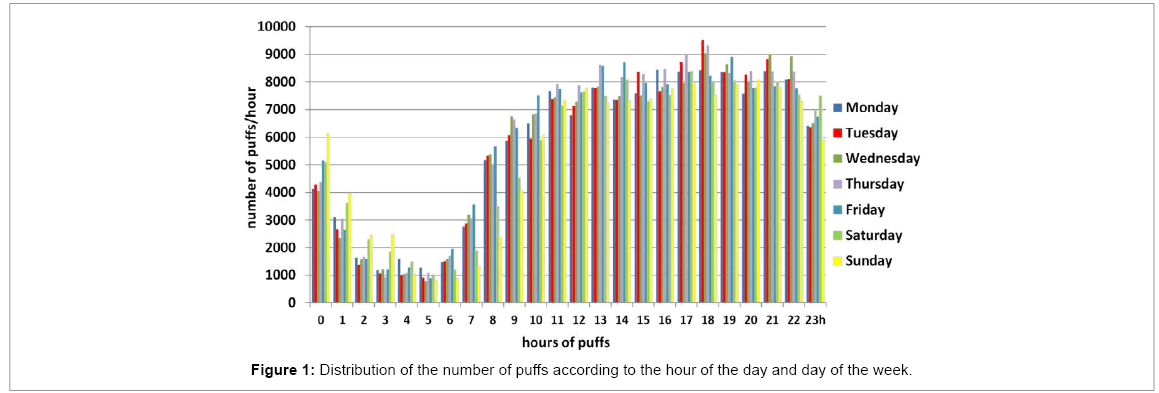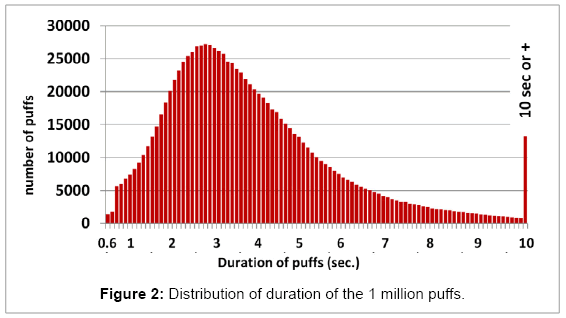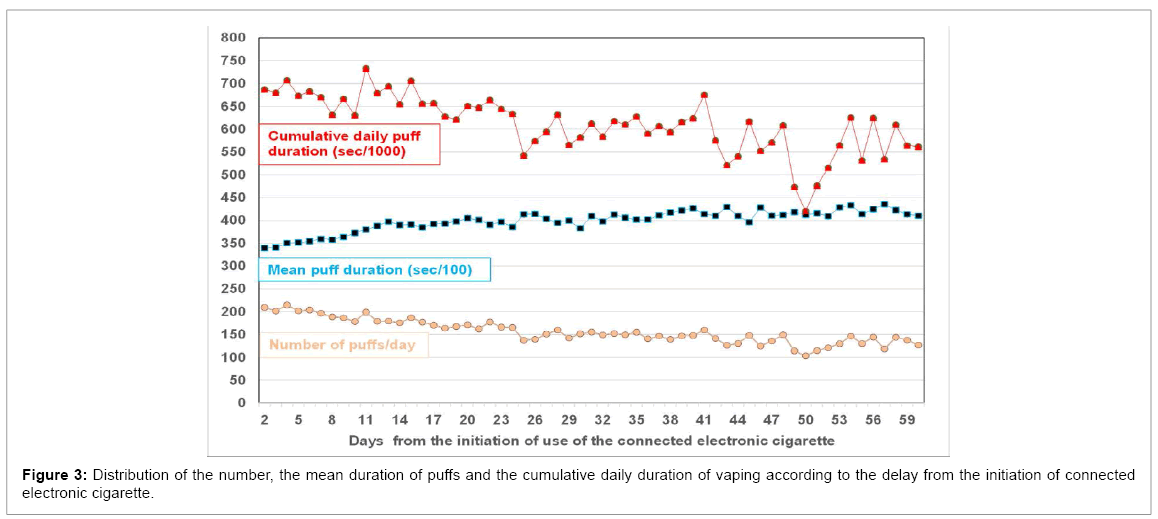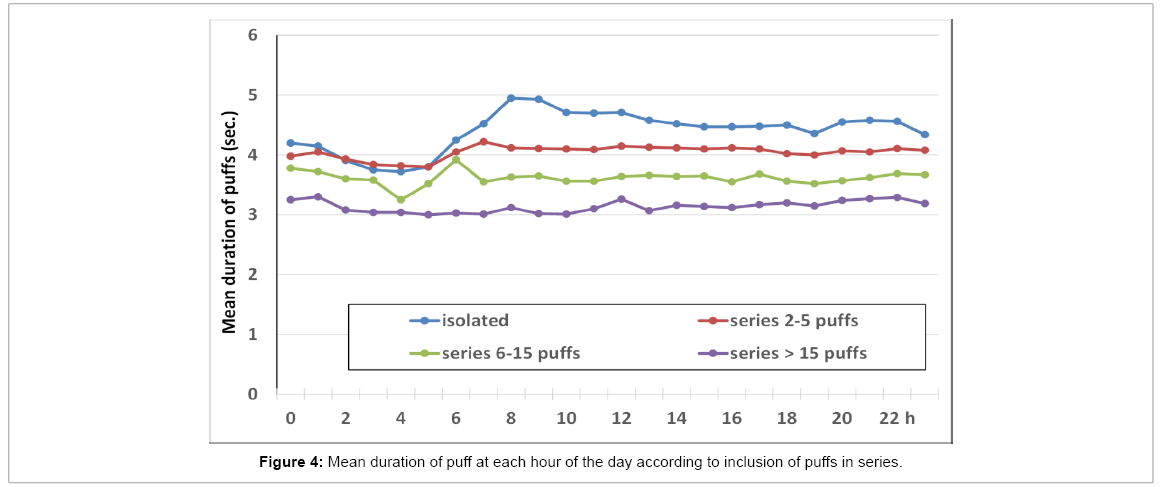Research Article Open Access
Real-Time Characterization of E-Cigarettes Use: The 1 Million Puffs Study
Bertrand Dautzenberg1,2* and Damien Bricard31Chest Department, University hospital Pitié Salpêtrière – Charles Foix (APHP), Paris, France
2University Pierre & Marie Curie (UMPC), Paris, France
3Institut National d’Etudes Démographiques (INED), Paris,
- Corresponding Author:
- Bertrand Dautzenberg
MD, Chest Department
Service de pneumologie Universitary Hospitals
Pitié Salpêtrière-Charles Foix
75651 Paris cedex 13, France
Tel: +33 61 343 7048
E-mail: bdautz@gmail.com
Received date: February 25, 2015 Accepted date: June 11, 2015; Published date: June 17, 2015
Citation: Dautzenberg B, Bricard D (2015) Real-Time Characterization of E-Cigarettes Use: The 1 Million Puffs Study. J Addict Res Ther 6:229. doi:10.4172/2155-6105.1000229
Copyright: © 2015 Dautzenberg B, et al. This is an open-access article distributed under the terms of the Creative Commons Attribution License, which permits unrestricted use, distribution, and reproduction in any medium, provided the original author and source are credited.
Visit for more related articles at Journal of Addiction Research & Therapy
Abstract
The use of the electronic cigarette is now common, but the characteristic of its use remains largely unknown.
Method: We have analysed the parameters of 1 million puffs recorded by a connected e-cigarette (Smokio®).
Results: 2,001 to 23,123 puffs (median=5,405) had been produced by each of the 185 users during the 116 days of the study period. The mean puffs number by user/day is 163±138 (median: 132) with large variations between users and days for the same user. The number of puffs/day decreases significantly on week-ends compared to the first 3 days of the week (-4.60%; p<0.001). The number of puffs/hour is stable from 10:00-10:00 pm but decreases during the night time. The mean puffs duration is of 3.79±1.89s (median=3.40s). Mean puffs duration increases from 3.40±1.33s the first day of use to 4.11±1.55s after 60 days (p<0.001).
The mean duration of puffs is higher for isolated puffs (4.57±2.24s) than for series >15 puffs (3.20±1.61s) (p<0.001). The puff series contains a median of 7 consecutive puffs (mean 11.68±14.52). During the first 60-day of use, the rate of isolated puff increased from 8.14% to 11.25% (p<0.001) and the mean number of puffs by series decreased from 6.78.±8.13 to 4.66±5.07 (p<0.001). During the same 60 days of use, the number of puffs/day decreased from 209 to 127 and the puffs are less often isolated (9.28%).
Conclusions: These results may help to better characterize the use of e-cigarettes in real-world and to propose setting of electronic cigarette testing machine to characterize e-liquid emissions.
Keywords
Electronic Cigarettes; Aerosol ; Big Data Analysis; Mobile Applications
Introduction
The electronic cigarette is the most used electronic nicotine delivery device (ENDS) [1-3], but how the product is used in realworld conditions is largely unknown. For public health it is essential to know better how ENDS are used in real conditions on a large scale, as well as assessing their content, safety, and effects on the users [4]. Some studies followed users and characterized self-reported use [5-6]. Another study proposed a puffing regimen to assess electronic cigarette emission [7]. Our study can bridge the gap between self-report in large surveys and data collected in artificial laboratory settings and offer a first ecological evaluation of electronic cigarette use according to time as recommended for Ecological Momentary (EMA) [8].
In Europe, the new Directive 2014/40/EU on tobacco products [9] addressed ENDS as a new product, not classifying it as a tobacco or medicinal product. The EU requiring that all producers characterize ENDS emissions before June 2016. However, standard parameters to test ENDS emissions are not yet available. Dense repeated measures data collected in real time are necessary to know the parameters of ENDS use.
A new connected ENDS with integrated monitoring was launched in France in February 2014 (Smokio®; http://us.smokio.com). This connected electronic cigarette automatically records all pressures on the switch that induce arrival of electric power in the resistance of the atomizer which generates vaporization of the e-liquid. In this paper, we report the analysis of the first 1 million puffs generated by this device, which should provide a basis to set electronic cigarette testing machine parameters for standardization of the characterization of ENDS emissions, based on real-world data in a group of French ENDS users with an eGO type of electronic cigarette similar to the most popular device used by French vapers.
Methods
Devices and users
The electronic cigarette studied uses a specific electronic control connected to a standard eGO type battery: Lithium-ion battery with 3.7 V nominal value and capacity of 650 or 900 mAh. There are 2 types of clearomizers included in the Smokio® kits of the present study: version 1 (sold from February to May 2014) included a CE 5.2 glass clearomizer with dual coil, an impedance of 1.8 to 2.0 ohms and a capacity of 1.6 ml, and version 2 kits (sold since June 2014) included a Evod 2 Pyrex clearomizer with dual coil, an impedance of 1.5 ohms and a capacity of 1.5 ml. In addition other types of clearomizers can be screwed onto the Smokio® batteries.
Data were recorded from February 24, 2014, when the product was launched on the market. To obtain a reliable sample, we decided to analyse 1 million puffs (users with less than 2,000 puffs in the data base were excluded). This was achieved by June 20, 2014. Only puffs >0.5 s are recorded because a minimal heating duration is required to raise the temperature enough to vaporize the e-liquid. The electronic system switches off after 10 s to prevent over-heating.
Three parameters are automatically recorded 1 million times by the device, without any human intervention: Identification of the device, exact time of initiation of a puff and duration of the puff in milliseconds. We associated one device to one user because the timing of puffs indicates that each electronic cigarette was not used by more than one person. The first version of Smokio® software had no geolocation and we had been informed that some products had been sold in the USA. Consequently, we identified on the database the daily hours of non-use of the device, and these hours of non-use were assumed to be night hours at local place of use. A total of self-selected 173 users (94% of the sample) used the device in the European time zone and 12 users were in the USA time zone (6%).
Information on user sex, age or concomitant use of tobacco products or other ENDS has not been automatically collected and is not included in the main database and not considered for the present study. Only the 3 parameters directly generated by the device are taken into account in the study. All users have given their consent for storing data and anonymous transmission to a third party for analysis. The database is declared to the French data protection authority (CNIL). The extracted file of the data base transmitted to the authors is totally anonymized.
Definitions
The time between two puffs was defined as the period between the initiations of puffs, least the duration of the first puff. For the analysis we defined:
• “isolated puff”, when no puff occurred 60 s before or 60 s after a puff;
• “short series of puffs” when 2 to 5 puffs occurred with less than 60 s between puffs;
• “series of puffs similar to cigarette use” when 6 to 15 puffs occurred with less than 60 s between puffs;
• “long series of puffs” when more than 15 puffs occurred with less than 60 s between puffs.
Statistical analysis
Descriptive statistics of puffs are presented as mean ± SD and/or median. Means are compared by Student test. We estimate both within and between user variability over repeated observations and the relative importance of between-user effect using ANOVA.The trends over time of user’s experience were tested using regression analysis, with mean puff duration, number of puffs/day and cumulative daily duration of vaporization as dependent variable at an individual level.
As each user has many days of data recording, we used the generalized estimating equations (GEE) approach with an exchangeable correlation structure to allow for correlated outcome measurements within each individual [10] and reported trend coefficients and its p-value in parenthesis. Trends over time were estimated starting at the first full day of use (excluding first day of data collection) and over the first 60 days.
Results
Users
During the first week of the launch of the product on the market the number of electronic cigarettes used was only 10, but then increased progressively. One million puffs were produced from connected electronic cigarette by 185 users in 116 days, during the first semester of 2014 (February 24 to June 20). The number of puffs per user in the data base varied from 2,001 to 23,123 (median per user =3,642 puffs). The total number of day-use for the 185 users was 6,144. The mean duration of use was 47.4 ± 25.3 days (range 7-112 days).
Number of puffs per day
The number of puffs/day of use varied from 1 to 1,265 per user. The mean number of puffs/day was 163 ± 138 (median=132) for the 6,144 days-use analysed with important variability between-users (97) and within-users (105). Between-users effects explaining 41.3% of the variance in ANOVA. After removing days of use with less than 5 puffs (n=259; 4.22% of day-use), the median rose only to 140 puffs/day.
Globally, 80% of puffs/day ranged from 16 to 346, and 50% ranged from 55 to 236. Only very few users produced more than 600 puffs/day: in 99% of day-use the number of puffs/day was lower than 567. One user produced over 4 days more than 1,000 puffs/day. This user used the connected ENDS only for 11 days, with a mean number of puffs/ day of 835.
Distribution of puffs according to the week-day and the hour in the day
The distribution of puffs changed according to the day of the week. Whereas the total number of puffs was not significantly different on Mondays, Tuesdays and Wednesdays, the number of puffs significantly decreased during weekends (-4.60%; p<0.001) compared to the first 3 days of the week. But the number of puffs significantly increased on Thursdays-Fridays (+3.64%; p<0.001) compared to the first 3 days of the week (Figure 1).
The distribution of the 1 million puffs dramatically changed with the hour of the day, with a trough of consumption at 5am and a peak of consumption between 10am and 10pm. On Saturdays and Sundays the use was higher than in the week days from 0 to 3am (+34.9%; p<0.001), and lower in the early morning, from 6 to 10am (-30.1%; p<0.001) (Figure 1).
Duration of puffs
Each puff lasts from 0.6 s to 10 s as set by the design of the connected electronic cigarette studied. A minority of puffs (13%) lasted between 0.6 and 1.9 s, 51% lasted 2.0-4.0 s and 36% lasted 4.1-10 s. Only 1.5% of the puffs were interrupted10.0 s. The distribution of duration of puffs is shown on Figure 2. The mean duration of puffs was 3.79 ± 1.89 s (median=3.40 s) with similar variability between-user (1.37) and within-user (1.36); between-users effects explaining 47.8% of the variance in ANOVA.
Effect of the number of days of experience with the connected ENDS
Puff duration increased during the first months of use of the connected electronic cigarette. The mean puff duration was 3.40 ± 1.33 s on the first full day of use, but increased to 4.11 ± 1.55 s after 60 days since start of use. This increase in puff duration is estimated to 17.4 ms per day (p<0.001) in regression model during the first 60 days of use.
Over the same period the number of puffs/day decreased from 209 the first full day of use to 127 after 60 days with a estimated decrease of 1.27 puffs/day over the period (p<0.001); as a result of these divergent tendencies the cumulative daily duration of vaporization decreased from 687 s the first full day to 561 s at 60 days with a significant trend of decrease over time of 1.6 s per day since start (p<0.001) (Figure 3).
Grouping of puffs in series
Only a minority of puffs were “isolated puff”, without any other puff 60 s before or 60 s after. More puffs were produced in series (Table 1).
| % of puffs in this type of series | Puffs duration | Puffs interval | |
|---|---|---|---|
| Isolated puff | 9.28% | 4.57 ± 2.24 s | - |
| Serie 2-5 puffs | 31.35% | 4.07 ± 1.94 s | 19.26 ± 15.12 s |
| Serie 6-15 puffs | 36.68% | 3.73 ± 1.77 s | 16.77 ± 13.23 s |
| Serie>15 puffs | 22.68 | 3.20 ± 1.61 s | 13.68 ± 11.53 s |
Table 1: Characteristics of puffs in series.
The “long series of puffs” (16-201 puffs) represented 22.68 % of the puffs, but only 3.7 % of the series of puffs. The median number of puffs in a series was 7. The mean number of puffs by series was 4.02 ± 5.55 when including the 1 million puffs, and 5.82 ± 6.36 puffs when removing “isolated puff”. The mean duration of puffs was longer for “isolated puff” than for all categories of puffs in series (p<0.001) (Table 1).
The mean puff duration remains highest for single puffs throughout the day. Single puff duration was at its highest at 8-9 am. The maximum difference of duration of isolated puffs compared to puffs in long series was also observed in the morning (Figure 4).
The median interval between puffs in series was 13.0 s (mean: 16.56 ± 13.50 s). The puff-interval decreased with the length of series: in “short series of puffs” puff-interval was 19.26 ± 15.12 s. compared to 16.77 ± 13.23 s in “series of puffs similar to cigarette use” (p<0.001) and 13.68 ± 11.53 s. in “long series of puffs” (p<0.001). The mean number of puffs in series decreased with the number of days of the experience with the connected electronic cigarette. During the first 60-days period for each user, the rate of isolated puffs increased from 8.14% to 11.25% (p<0.001). The mean number of puffs in series decreased from 6.78 ± 8.13 to 4.66 ± 5.07 (p<0.001).
Discussion
Limitation of our study
This study, analyzing 2 quantitative parameters, time and duration, of 1 million puffs obtained from real-world data from a group of 185 mainly French users is the largest study reported on parameters of use of electronic cigarette. Recording of the data is automatic without bias introduced by human intervention.
We acknowledge that this analysis is limited to the type of electronic cigarette used, and could not reflect the use of 3rd generation (“Mods”) ENDS. However, the electronic cigarettes used for this study is close to an eG0 type, which is the type of ENDS used by most French electronic cigarette users.
The results concern only one brand of connected electronic cigarette sold from France, with no information about the users, so this first study has limitations for generalization of the results because the study is conducted with only one brand of electronic cigarette; different devices with different electric power applied to a different atomizer in a chamber of different volume may have different puffing patterns. Whereas the present study applies information automatically transmitted from devices, we have no information on user age, sex, concomitant use of tobacco or another electronic cigarette. Moreover, the puffing pattern may vary with climate, season, alcohol use, behavior change. The high number of recorded puffs may partly smooth out these potentially confusing factors but other studies, with other devices and a characterization of users are needed before drawing definitive conclusions. Nevertheless in the absence of more representative data the present results may be useful to help setting up standardization of electronic cigarettes testing machine to assess emissions.
In addition, the time of production of ENDS aerosol by vaporization (duration of pressure on the switch of the ENDS) measured in this study, could be slightly different from the time of inhalation by user. In the present study, we have no data on inspiration flow. New studies are warranted to measure the difference between these two parameters and to assess the influence of the concentration of nicotine in e-liquid on the puffing pattern, not taken into account by the present study.
Discussion of results
The median number of puffs per day was 132. After removing days of use with less than 5 puffs, the median rises to 140 puffs / day. The number of puffs per day varied considerably from one user to another. However, it should be noted that whereas a large minority of individuals take more than 140 puffs per day, only 14.60% of daily usage exceeds 300 puffs. Less than 1% of day-users reach 600 puffs. Such heterogeneity justifies studies on large-scale data.
The number of puffs decreases as experience of the connected e-cigarette increases. The number of puffs per day decreased on weekends compared to week days. The best explanation for this reduction in recorded puffs on weekend days (from midnight to midnight) is a reduction in the duration of vaping on Saturday and Sunday because of a late wake up this weekend days, only very partially compensated by the puffs produced between 0 hours and bedtime in the first hours of the day.
The mean puffs duration was close to 4 s (3.8 s). Inter-individual and intra-individual distribution of the mean duration of puffs is also heterogenic. The duration of puff is longer when the puff is isolated. The duration of puffs also increased with the number of days of experience of the connected electronic cigarettes. But because the number of puffs decreases to a greater extent, the cumulative daily duration of vaping decreases by 2.6 s. per day during the first 60 days of use of the connected electronic cigarette. The duration of puff is an important parameter because it determines, with the concentration of nicotine in e-liquids, the quantity of nicotine emission, as well as other compounds. A minority of puffs (9.28%) are isolated without any puff within 60 s before or after. Most of the puffs are included in a series of puffs. In series of grouped puffs, the median number of puffs is 7 and the median puff-interval 13 s.
Proposal for electronic cigarettes testing machine setting
Previously Goniewicz et al. [7] had used to asses ENDs emission, without previous large survey, a protocol with series of 15 puffs with puff-interval of 10 s for a total of 300 puffs. According to our results we proposed parameters based the 1 million puffs recorded in real-world conditions. Running 20 series of 7 puffs lasting 4 s each, separated by a puff-interval of 13 s, with an interval of 2 min between the 20 series, will provide 140 puffs, representing a total of 560 s of vaporization, in a 75 min protocol.
Proposal for future studies
Studies are needed that could combine this type of new tracking device and the information gathered in the present study, with other methods such as survey measures, personal digital devices (e.g. brief additional tracking and self-report responses made on a cell phone application; or spatial tracking of the proximal environment). Such studies can then be used to triangulate devices, multiple measures and mixed-modes of measurement to better address research gaps that no single measure, method or device can capture alone.
Acknowledgements
Smokio® (Paris, France) has graciously provided the extraction of 1 million puffs data from their database of first users of the Smokio connected e-cigarette.
What This Paper Adds
1. Electronic cigarettes are widely used, but the characteristics of puffs have not been analysed on very large series. The present big data study is far the largest assessment of e-cigarettes puffs analysis in a real world.
2. Present study reports a characterization of 1 million e-cigarette puffs.
• The median puffs duration is 3.4 seconds, value close to previous studies.
• Present study show that 90% of puffs are in series (median 7 puffs grouped).
• Present study show that the numbers of puffs decrease and the duration of puffs increase the first 2 months of use.
• Present study showed that progressively during the first 2 months of use the mean number of puffs in series decreases, the puffs became more equally distributed, with a higher duration but decrease in number.
3. Findings of present study may help to set parameter of test machine for e-cigarette to assess in standards conditions the emissions of e-cigarette.
References
- Jamie Brown, Emma Beard, Daniel Kotz, Susan Michie, Robert West (2014) Real-world effectiveness of e-cigarettes when used to aid smoking cessation: a cross-sectional population study. Addiction109: 1531-1540.
- Giovenco DP, Lewis MJ, Delnevo CD (2014) Factors Associated with E-cigarette Use: A National Population Survey of Current and Former Smokers. Am J Prev Med47: 476-80.
- http://www.ofdt.fr/BDD/publications/docs/eisaalu2.pdf
- Peter Hajek, Jean-François Etter, Neal Benowitz, Thomas Eissenberg, HaydenMcRobbie (2014) Electronic cigarettes: review of use, content, safety, effects on smokers and potential for harm and benefit. Addiction109:1801-10.
- Etter JF, Bullen C (2014) A longitudinal study of electronic cigarette users. Addict Behav 39: 491-494.
- Farsalinos KE, Romagna G, Tsiapras D (2014). Characteristics, perceived side effects and benefits of electronic cigarette use: a worldwide survey of more than 19,000 consumers. Int J Environ Res Public Health11: 4356-4373.
- Goniewicz ML, Hajek P, Mc Robbie H (2014) Nicotine content of electronic cigarettes, its release in vapour and its consistency across batches: regulatory implications. Addiction109: 500-507.
- Shiffman S (2009) Ecological Momentary Assessment (EMA) in studies of substance use. Psychol Assess21: 486-497.
- http://ec.europa.eu/health/tobacco/docs/dir_201440_en.pdf
- Liang KY, Zeger SL (1986) Longitudinal Data Analysis Using Generalized Linear Models.Biometrika73 : 13-22.
Relevant Topics
- Addiction Recovery
- Alcohol Addiction Treatment
- Alcohol Rehabilitation
- Amphetamine Addiction
- Amphetamine-Related Disorders
- Cocaine Addiction
- Cocaine-Related Disorders
- Computer Addiction Research
- Drug Addiction Treatment
- Drug Rehabilitation
- Facts About Alcoholism
- Food Addiction Research
- Heroin Addiction Treatment
- Holistic Addiction Treatment
- Hospital-Addiction Syndrome
- Morphine Addiction
- Munchausen Syndrome
- Neonatal Abstinence Syndrome
- Nutritional Suitability
- Opioid-Related Disorders
- Relapse prevention
- Substance-Related Disorders
Recommended Journals
Article Tools
Article Usage
- Total views: 45795
- [From(publication date):
June-2015 - Nov 21, 2024] - Breakdown by view type
- HTML page views : 41021
- PDF downloads : 4774




